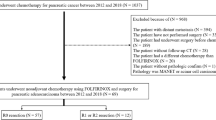Abstract
Purpose
To compare the survival outcomes in patients with pancreatic ductal adenocarcinoma (PDAC) who had regular imaging surveillance with those who had clinical follow-up after Whipple.
Method
We identified 229 patients, who underwent Whipple for resection of PDAC from 2005 to 2011, and had regular postoperative clinical follow-up at our hospital. Patients were retrospectively selected for two follow-up groups: imaging surveillance (IS) defined as routine imaging at scheduled intervals, vs. clinical (C) defined as imaging triggered by either change in clinical status or change in CA19-9. Follow-up was obtained through the hospital and Cancer Data Registry records. Survival was calculated from the date of surgery to death or last follow-up, with data censored as of March 13, 2013. Kaplan–Meier survival curves were compared using the log-rank test, and Cox regression models were used for multivariate analysis.
Results
Patients were followed for a mean period of 24.35 ± 2.56 months. IS-group underwent significantly more imaging (4.41 vs. 2.08 scans/year). The most frequent imaging was CT of chest and abdomen at 3–4 month interval. Univariate associations with overall survival were detected with post-Whipple ECOG status, T-stage, N-stage, tumor grade, surgical margin, recurrence, and IS. In multivariate analysis, grade, ECOG status, and recurrence were independent predictors of survival. Also, our predictor of interest, IS, was highly associated with longer survival in multivariate modeling (median overall survival, 30.4±3.85 (IS-group) vs. 17.1 ± 2.42 (C-groups) month, log-rank p = 0.002).
Conclusion
Routine imaging surveillance was associated with prolonged overall survival post-Whipple in a multivariate model. This is a hypothesis-generating finding that should be studied prospectively and could ultimately impact surveillance guidelines.


Similar content being viewed by others
References
Cancer Facts and Figures (2016) acspc-047079.pdf. http://www.cancer.org/acs/groups/content/@research/documents/document/acspc-047079.pdf. Accessed 2 Dec 2016
Ferrone CR, Brennan MF, Gonen M, et al. (2008) Pancreatic adenocarcinoma: the actual 5-year survivors. J Gastrointest Surg Off J Soc Surg Aliment Tract 12:701–706
Jemal A, Siegel R, Xu J, Ward E (2010) Cancer statistics, 2010. CA Cancer J Clin 60:277–300
Hoem D, Viste A (2012) Improving survival following surgery for pancreatic ductal adenocarcinoma–a ten-year experience. Eur J Surg Oncol J Eur Soc Surg Oncol Br Assoc Surg Oncol 38:245–251
Ferrone CR, Pieretti-Vanmarcke R, Bloom JP, et al. (2012) Pancreatic ductal adenocarcinoma: long-term survival does not equal cure. Surgery 152:S43–S49
Sener SF, Fremgen A, Menck HR, Winchester DP (1999) Pancreatic cancer: a report of treatment and survival trends for 100,313 patients diagnosed from 1985-1995, using the National Cancer Database. J Am Coll Surg 189:1–7
Oettle H, Post S, Neuhaus P, et al. (2007) Adjuvant chemotherapy with gemcitabine vs observation in patients undergoing curative-intent resection of pancreatic cancer: a randomized controlled trial. JAMA 297:267–277
Lim JE, Chien MW, Earle CC (2003) Prognostic factors following curative resection for pancreatic adenocarcinoma: a population-based, linked database analysis of 396 patients. Ann Surg 237:74–85
Riediger H, Keck T, Wellner U, et al. (2009) The lymph node ratio is the strongest prognostic factor after resection of pancreatic cancer. J Gastrointest Surg Off J Soc Surg Aliment Tract 13:1337–1344
Van den Broeck A, Sergeant G, Ectors N, et al. (2009) Patterns of recurrence after curative resection of pancreatic ductal adenocarcinoma. Eur J Surg Oncol J Eur Soc Surg Oncol Br Assoc Surg Oncol 35:600–604
Kleeff J, Reiser C, Hinz U, et al. (2007) Surgery for recurrent pancreatic ductal adenocarcinoma. Ann Surg 245:566–572
Witkowski ER, Smith JK, Ragulin-Coyne E, et al. (2012) Is it worth looking? Abdominal imaging after pancreatic cancer resection: a national study. J Gastrointest Surg Off J Soc Surg Aliment Tract 16:121–128
Sheffield KM, Crowell KT, Lin Y-L, et al. (2012) Surveillance of pancreatic cancer patients after surgical resection. Ann Surg Oncol 19:1670–1677
Castellanos JA, Merchant NB (2014) Intensity of follow-up after pancreatic cancer resection. Ann Surg Oncol 21:747–751
Nordby T, Hugenschmidt H, Fagerland MW, et al. (2013) Follow-up after curative surgery for pancreatic ductal adenocarcinoma: asymptomatic recurrence is associated with improved survival. Eur J Surg Oncol J Eur Soc Surg Oncol Br Assoc Surg Oncol 39:559–566
Heye T, Zausig N, Klauss M, et al. (2011) CT diagnosis of recurrence after pancreatic cancer: is there a pattern? World J Gastroenterol 17:1126–1134
Vincent A, Herman J, Schulick R, Hruban RH, Goggins M (2011) Pancreatic cancer. Lancet Lond Engl 378:607–620
Liao W-C, Chien K-L, Lin Y-L, et al. (2013) Adjuvant treatments for resected pancreatic adenocarcinoma: a systematic review and network meta-analysis. Lancet Oncol 14:1095–1103
Han S-S, Jang J-Y, Kim S-W, et al. (2006) Analysis of long-term survivors after surgical resection for pancreatic cancer. Pancreas 32:271–275
Rau BM, Moritz K, Schuschan S, et al. (2012) R1 resection in pancreatic cancer has significant impact on long-term outcome in standardized pathology modified for routine use. Surgery 152:S103–S111
Konstantinidis IT, Warshaw AL, Allen JN, et al. (2013) Pancreatic ductal adenocarcinoma: is there a survival difference for R1 resections versus locally advanced unresectable tumors? What is a “true” R0 resection? Ann Surg 257:731–736
Laurence JM, Tran PD, Morarji K, et al. (2011) A systematic review and meta-analysis of survival and surgical outcomes following neoadjuvant chemoradiotherapy for pancreatic cancer. J Gastrointest Surg Off J Soc Surg Aliment Tract 15:2059–2069
Colbert LE, Hall WA, Nickleach D, et al. (2014) Chemoradiation therapy sequencing for resected pancreatic adenocarcinoma in the National Cancer Data Base. Cancer 120:499–506
Author information
Authors and Affiliations
Corresponding author
Ethics declarations
Funding
No funding was received for this study.
Conflict of interest
The authors declare that they have no conflict of interest.
Ethical approval
All procedures performed in studies involving human participants were in accordance with the ethical standards of the institutional and/or National Research Committee and with the 1964 Helsinki declaration and its later amendments or comparable ethical standards.
Informed consent
Statement of informed consent was not applicable since the manuscript does not contain any patient data.
Rights and permissions
About this article
Cite this article
Elmi, A., Murphy, J., Hedgire, S. et al. Post-Whipple imaging in patients with pancreatic ductal adenocarcinoma: association with overall survival: a multivariate analysis. Abdom Radiol 42, 2101–2107 (2017). https://doi.org/10.1007/s00261-017-1099-2
Published:
Issue Date:
DOI: https://doi.org/10.1007/s00261-017-1099-2




